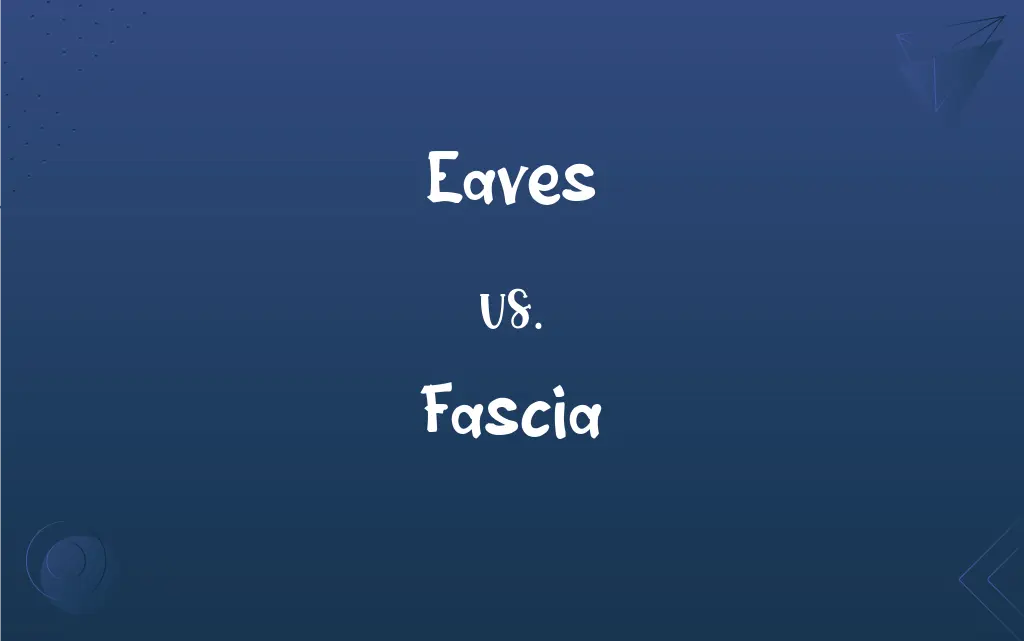Eaves vs. Fascia: What's the Difference?
By Harlon Moss & Janet White || Updated on May 23, 2024
Eaves are the edges of the roof that overhang the walls of a building, while fascia is the horizontal board along the edge of the roof, covering the ends of the rafters.

Key Differences
Eaves are the lower edges of a roof that extend beyond the building's walls, providing shade and protecting the walls from rainwater. They create an overhang that helps direct water away from the building’s foundation, thus preserving the structure's integrity. Fascia, on the other hand, is the horizontal board that runs along the edge of the roof. It covers the ends of the roof rafters and provides a surface for attaching gutters.
Eaves are an architectural feature that contributes to the aesthetic appeal and functionality of a building by offering shade and weather protection. They often include soffits on the underside to complete the look and improve ventilation. Fascia serves a more structural purpose by providing support for the lower edge of the roof and creating a finished look. It is essential for the installation of gutters, which help manage water runoff from the roof.
While eaves are typically more visible and prominent, extending outwards from the roof, fascia is usually a narrower strip of material attached directly to the roof edge. Eaves can vary in size and design, sometimes featuring decorative elements, whereas fascia is more standardized in appearance and function.
Eaves can be open or closed, with closed eaves often incorporating a soffit to seal the underside. Open eaves expose the rafters and are more common in certain architectural styles. Fascia, regardless of the type of eaves, plays a crucial role in maintaining the roof's edge and ensuring that gutters are securely fastened.
Comparison Chart
Function
Extends roof beyond walls
Covers rafter ends, supports gutters
ADVERTISEMENT
Location
Edges of the roof, overhanging walls
Along the edge of the roof
Aesthetic Contribution
Provides architectural appeal and shade
Creates a finished edge look
Structural Role
Directs water away from foundation
Supports the lower edge of the roof
Variability
Can be open or closed, decorative
Typically standardized in design
Eaves and Fascia Definitions
Eaves
A protective architectural feature extending beyond the building walls.
Rainwater dripped from the eaves, forming puddles below.
ADVERTISEMENT
Fascia
A structural component of the roof edge.
The gutters were securely attached to the fascia.
Eaves
The part of a roof that projects beyond the wall.
Birds often nested in the eaves of the old barn.
Fascia
A part of the roof providing support for gutters.
Water damage to the fascia required immediate repair.
Eaves
An element that enhances the building’s exterior design.
The eaves were decorated with intricate woodwork.
Fascia
The board that creates a finished edge look on a roof.
Replacing the old fascia improved the house’s curb appeal.
Eaves
The overhanging edges of a roof.
The wide eaves of the house provided ample shade in the summer.
Fascia
A sheet or band of fibrous connective tissue enveloping, separating, or binding together muscles, organs, and other soft structures of the body.
Eaves
Roof edges designed to prevent water damage to walls.
Snow accumulated on the eaves during the winter storm.
Fascia
The tissue of which such a sheet or band is composed.
Eaves
(architectural element) The underside of a roof that extends beyond the external walls of a building.
Fascia
(Biology) A broad and distinct band of color.
Eaves
(by extension) Something that extends over or projects beyond.
Fascia
A flat horizontal band or member between moldings, especially in a classical entablature.
Eaves
Plural of eave
Fascia
(fāshə) pl. fas·cias A board covering the ends of rafters on the eaves of a building. Also called fascia board.
Eaves
The edges or lower borders of the roof of a building, which overhang the walls, and cast off the water that falls on the roof.
Fascia
The shape or styling of the front or rear end of an automobile.
Eaves
Brow; ridge.
Fascia
Chiefly British The dashboard of a motor vehicle.
Eaves
Eyelids or eyelashes.
And closing eaves of wearied eyes.
Fascia
(architectural element) A wide band of material covering the ends of roof rafters, sometimes supporting a gutter in steep-slope roofing, but typically it is a border or trim in low-slope roofing.
Eaves
The overhang at the lower edge of a roof
Fascia
A face or front cover of an appliance, especially of a mobile phone.
Fascia
(UK) A dashboard.
Fascia
(architectural element) A flat band or broad fillet; especially, one of the three bands that make up the architrave, in the Ionic order.
Fascia
A broad well-defined band of color.
Fascia
A band, sash, or fillet; especially, in surgery, a bandage or roller.
Fascia
A sash worn by certain members of the Catholic and Anglican churches.
Fascia
(anatomy) The layer of loose tissue, often containing fat, immediately beneath the skin; the stronger layer of connective tissue covering and investing muscles and organs; an aponeurosis.
Fascia
The signboard above a shop or other location open to the public.
Fascia
A band, sash, or fillet; especially, in surgery, a bandage or roller.
Fascia
A flat member of an order or building, like a flat band or broad fillet; especially, one of the three bands which make up the architrave, in the Ionic order. See Illust. of Column.
Fascia
The layer of loose tissue, often containing fat, immediately beneath the skin; the stronger layer of connective tissue covering and investing all muscles; an aponeurosis.
Fascia
A broad well-defined band of color.
Fascia
A sheet or band of fibrous connective tissue separating or binding together muscles and organs etc
Fascia
A horizontal board covering the ends of roof rafters.
The new fascia boards were painted white to match the trim.
Fascia
A critical element in maintaining the roof's integrity.
The fascia helps protect the roof from wind and rain.
FAQs
What is the primary function of fascia?
Fascia covers the ends of the roof rafters and supports the gutters.
Are fascia boards necessary for gutter installation?
Yes, fascia boards provide the necessary support for attaching gutters.
How do eaves protect a building?
Eaves direct rainwater away from the walls and foundation, preventing water damage.
Can eaves be decorative?
Yes, eaves can include decorative elements and enhance the aesthetic appeal of a building.
How are eaves different from soffits?
Eaves are the overhanging part of the roof, while soffits are the underside covering of the eaves.
What are eaves?
Eaves are the edges of a roof that extend beyond the walls of a building, providing shade and weather protection.
Can fascia boards be replaced separately from the roof?
Yes, damaged fascia boards can be replaced without replacing the entire roof.
Are there different styles of eaves?
Yes, eaves can vary in design, including features like decorative brackets or exposed rafters.
What materials are commonly used for fascia?
Fascia boards can be made from wood, vinyl, aluminum, or composite materials.
Do eaves contribute to energy efficiency?
Yes, by providing shade, eaves can help reduce cooling costs in the summer.
Do all buildings have eaves?
Most buildings have eaves, but their design and size can vary depending on the architectural style.
How often should fascia boards be inspected?
Fascia boards should be inspected annually for signs of damage or decay.
Can fascia be part of a building's decorative trim?
Yes, fascia often matches or complements the building's exterior trim.
How does the climate affect eaves and fascia?
In harsh climates, both eaves and fascia need more frequent maintenance to prevent weather-related damage.
What role do fascia boards play in roof maintenance?
Fascia boards help protect the roof edge from weather and provide a stable base for gutters.
Why might eaves be open or closed?
Open eaves expose rafters and suit certain styles, while closed eaves with soffits provide a finished look and improve ventilation.
What happens if fascia boards are damaged?
Damaged fascia boards can lead to water damage and affect the stability of gutters.
Can eaves be retrofitted to an existing building?
Yes, eaves can be added or extended on existing buildings to improve protection and aesthetics.
Do fascia boards need to be painted?
Painting fascia boards can help protect them from weathering and enhance their appearance.
What maintenance do eaves require?
Eaves require regular cleaning to remove debris and inspection for damage or leaks.
About Author
Written by
Harlon MossHarlon is a seasoned quality moderator and accomplished content writer for Difference Wiki. An alumnus of the prestigious University of California, he earned his degree in Computer Science. Leveraging his academic background, Harlon brings a meticulous and informed perspective to his work, ensuring content accuracy and excellence.
Co-written by
Janet WhiteJanet White has been an esteemed writer and blogger for Difference Wiki. Holding a Master's degree in Science and Medical Journalism from the prestigious Boston University, she has consistently demonstrated her expertise and passion for her field. When she's not immersed in her work, Janet relishes her time exercising, delving into a good book, and cherishing moments with friends and family.
































































